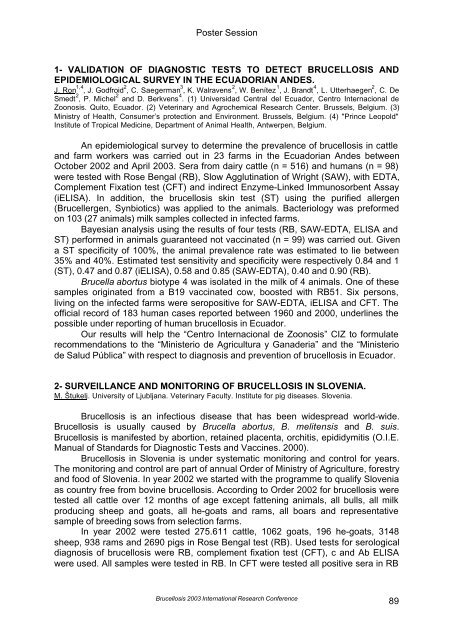Brucellosis 2003 proceedings - PHIDIAS
Brucellosis 2003 proceedings - PHIDIAS
Brucellosis 2003 proceedings - PHIDIAS
Create successful ePaper yourself
Turn your PDF publications into a flip-book with our unique Google optimized e-Paper software.
Poster Session<br />
1- VALIDATION OF DIAGNOSTIC TESTS TO DETECT BRUCELLOSIS AND<br />
EPIDEMIOLOGICAL SURVEY IN THE ECUADORIAN ANDES.<br />
J. Ron 1,4 , J. Godfroid 2 , C. Saegerman 3 , K. Walravens 2 , W. Benítez 1 , J. Brandt 4 , L. Utterhaegen 2 , C. De<br />
Smedt 2 , P. Michel 2 and D. Berkvens 4 . (1) Universidad Central del Ecuador, Centro Internacional de<br />
Zoonosis. Quito, Ecuador. (2) Veterinary and Agrochemical Research Center. Brussels, Belgium. (3)<br />
Ministry of Health, Consumer’s protection and Environment. Brussels, Belgium. (4) "Prince Leopold"<br />
Institute of Tropical Medicine, Department of Animal Health, Antwerpen, Belgium.<br />
An epidemiological survey to determine the prevalence of brucellosis in cattle<br />
and farm workers was carried out in 23 farms in the Ecuadorian Andes between<br />
October 2002 and April <strong>2003</strong>. Sera from dairy cattle (n = 516) and humans (n = 98)<br />
were tested with Rose Bengal (RB), Slow Agglutination of Wright (SAW), with EDTA,<br />
Complement Fixation test (CFT) and indirect Enzyme-Linked Immunosorbent Assay<br />
(iELISA). In addition, the brucellosis skin test (ST) using the purified allergen<br />
(Brucellergen, Synbiotics) was applied to the animals. Bacteriology was preformed<br />
on 103 (27 animals) milk samples collected in infected farms.<br />
Bayesian analysis using the results of four tests (RB, SAW-EDTA, ELISA and<br />
ST) performed in animals guaranteed not vaccinated (n = 99) was carried out. Given<br />
a ST specificity of 100%, the animal prevalence rate was estimated to lie between<br />
35% and 40%. Estimated test sensitivity and specificity were respectively 0.84 and 1<br />
(ST), 0.47 and 0.87 (iELISA), 0.58 and 0.85 (SAW-EDTA), 0.40 and 0.90 (RB).<br />
Brucella abortus biotype 4 was isolated in the milk of 4 animals. One of these<br />
samples originated from a B19 vaccinated cow, boosted with RB51. Six persons,<br />
living on the infected farms were seropositive for SAW-EDTA, iELISA and CFT. The<br />
official record of 183 human cases reported between 1960 and 2000, underlines the<br />
possible under reporting of human brucellosis in Ecuador.<br />
Our results will help the “Centro Internacional de Zoonosis” CIZ to formulate<br />
recommendations to the “Ministerio de Agricultura y Ganaderia” and the “Ministerio<br />
de Salud Pública” with respect to diagnosis and prevention of brucellosis in Ecuador.<br />
2- SURVEILLANCE AND MONITORING OF BRUCELLOSIS IN SLOVENIA.<br />
M. Štukelj. University of Ljubljana. Veterinary Faculty. Institute for pig diseases. Slovenia.<br />
<strong>Brucellosis</strong> is an infectious disease that has been widespread world-wide.<br />
<strong>Brucellosis</strong> is usually caused by Brucella abortus, B. melitensis and B. suis.<br />
<strong>Brucellosis</strong> is manifested by abortion, retained placenta, orchitis, epididymitis (O.I.E.<br />
Manual of Standards for Diagnostic Tests and Vaccines. 2000).<br />
<strong>Brucellosis</strong> in Slovenia is under systematic monitoring and control for years.<br />
The monitoring and control are part of annual Order of Ministry of Agriculture, forestry<br />
and food of Slovenia. In year 2002 we started with the programme to qualify Slovenia<br />
as country free from bovine brucellosis. According to Order 2002 for brucellosis were<br />
tested all cattle over 12 months of age except fattening animals, all bulls, all milk<br />
producing sheep and goats, all he-goats and rams, all boars and representative<br />
sample of breeding sows from selection farms.<br />
In year 2002 were tested 275.611 cattle, 1062 goats, 196 he-goats, 3148<br />
sheep, 938 rams and 2690 pigs in Rose Bengal test (RB). Used tests for serological<br />
diagnosis of brucellosis were RB, complement fixation test (CFT), c and Ab ELISA<br />
were used. All samples were tested in RB. In CFT were tested all positive sera in RB<br />
<strong>Brucellosis</strong> <strong>2003</strong> International Research Conference<br />
89
















